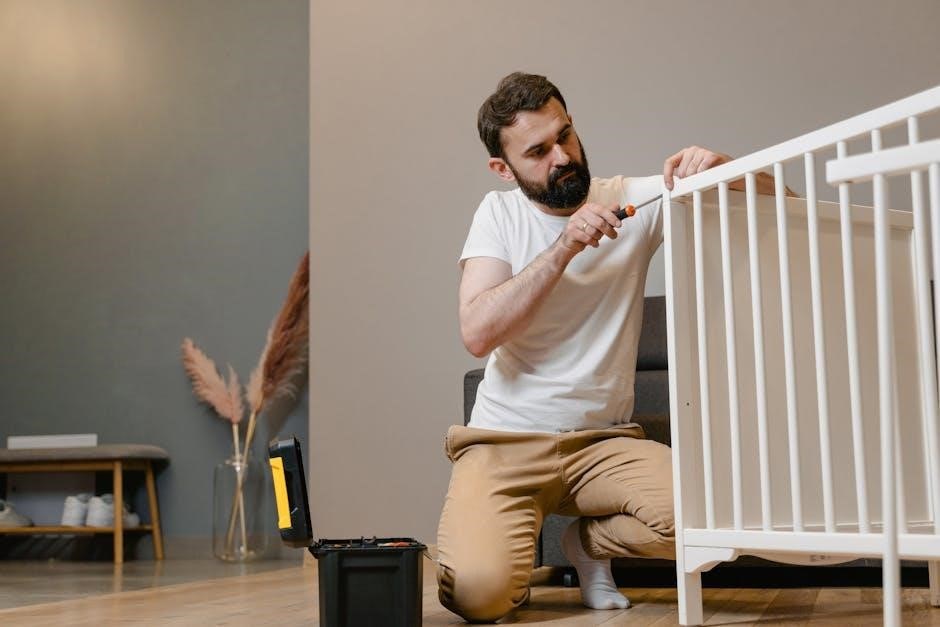Removing the bed of your 2001 Toyota Tundra Access Cab is essential for maintenance, repairs, or upgrades. This guide provides a comprehensive walkthrough of the process, ensuring safety and efficiency. Proper preparation and tools are crucial to avoid damage and ensure successful bed removal. Follow these steps carefully to achieve professional results.

Preparation
Begin by assessing the truck’s condition, researching detailed instructions, and gathering necessary tools. Protect the surrounding area and ensure all utilities are safely disconnected before starting the process.

2.1 Assessing the Truck’s Condition
Before starting, inspect the truck’s bed for rust, especially under the liner, as seen in similar models like the 2003 V8 Access Cab Tundra. Check for any damage or wear on the bed and its mounting points. Ensure all bolts and fasteners are secure and free from excessive corrosion. Verify the truck’s mileage and overall condition to anticipate potential challenges during removal. If rust is present, plan for additional cleaning or repair steps post-removal. This assessment helps in preparing the right tools and strategies, ensuring a smooth process. Always prioritize safety by addressing any structural weaknesses before proceeding.
2.2 Researching Instructions
Researching detailed instructions is crucial for a successful bed removal. Start by consulting the official Toyota service manual for your 2001 Tundra Access Cab, as it provides model-specific guidance. Additionally, online forums like the Toyota Tundra Discussion Forum offer valuable insights from experienced owners who have performed similar tasks. Look for tutorials or threads discussing bed removal on early 2000s Tundra models, as they often include tips for addressing common issues like rust or stuck bolts. Ensure the instructions are accurate and applicable to your truck’s specifications. Gathering multiple sources will help you understand the process thoroughly and prepare for any challenges. Always verify steps with the official manual to avoid relying on incorrect or generalized advice.
2.3 Gathering Tools and Equipment
Gathering the right tools and equipment is essential for a smooth bed removal process. Start with basic tools like a socket set, wrenches, screwdrivers, and pliers. A 3/8-inch or 1/2-inch impact wrench is highly recommended for loosening bed bolts. Additionally, you’ll need a torque wrench for precise bolt removal and a hydraulic jack or lift to safely elevate the truck. Specialized tools may include a bed removal harness or frame clips. Don’t forget protective materials like wood blocks or jack stands to support the truck and bed during removal. Ensure you have gloves, safety glasses, and a well-lit workspace. Organize all tools and equipment beforehand to avoid delays. Having everything ready will help you stay focused and efficient throughout the process.
2.4 Protecting the Surrounding Area
Protecting the surrounding area is crucial to prevent damage during the bed removal process. Cover the truck’s paint and windows with protective plastic sheets or tarps to shield them from dust, debris, or accidental scratches. Use drop cloths or old blankets to protect the garage floor or driveway from potential spills or falling tools. Ensure the area is clear of loose items that could get lost or damaged. Secure any nearby equipment or tools to avoid accidents. Additionally, use jack stands or wooden blocks to stabilize the truck and bed during removal, preventing unintended movement. Safety glasses and gloves should also be worn to protect yourself while working. Taking these precautions ensures a clean and damage-free workspace throughout the process.
2.5 Disconnecting Utilities
Disconnecting utilities is essential to ensure safety and prevent damage during the bed removal process. Start by disconnecting the truck’s battery to avoid any electrical issues or accidental start-ups. Locate the fuel lines, brake lines, and electrical connectors attached to the bed and carefully disconnect them. Use wrenches or pliers to loosen fittings, and cap the lines to prevent fluid leaks or contamination. Drain the fuel tank or lines if necessary, following proper safety protocols. Label each disconnected component to facilitate easy reconnection later. If unsure about specific utilities, consult the repair manual or seek professional assistance. Properly securing and labeling disconnected utilities ensures a safe and organized removal process.

Tools and Equipment
Essential tools include wrenches, sockets, screwdrivers, pliers, and punches. Specialized tools like a Tundra bed removal kit may be needed. Ensure materials for protection and repair, such as protective covers, wood blocks, and silicone spray, are on hand to safeguard the truck and facilitate smooth reassembly.
3.1 Basic Tools Required
For removing the bed of a 2001 Toyota Tundra Access Cab, essential basic tools include a socket set with metric sizes, a wrench set, screwdrivers, pliers, and a breaker bar for added leverage. A torque wrench is necessary for precise bolt removal, while a floor jack and jack stands are critical for safely lifting and supporting the truck. WD-40 or penetrating oil can help loosen stubborn bolts, and a pry bar may be needed for gently dislodging stuck parts. Safety equipment like gloves and goggles should always be on hand. Ensure all tools are in good condition to avoid rounding bolts or causing damage during the process. Having these tools ready will streamline the removal and minimize potential delays or complications.
3.2 Specialized Tools Needed
Specialized tools are essential for safely and efficiently removing the bed of a 2001 Toyota Tundra Access Cab. An impact wrench is highly recommended for loosening stubborn bolts without damaging threads. A bed removal kit, specifically designed for this task, often includes bolts, clamps, and spacers to stabilize the bed during removal. Additionally, a set of tie-down straps or lifting straps can help secure the bed while lifting or lowering it. A hydraulic jack or lift is necessary for safely elevating the truck and supporting the bed during the process. Lastly, an electrical connector removal tool can help safely disconnect wiring harnesses connected to the bed. These tools ensure the job is done without causing damage to the truck or its components.
3.3 Materials for Protection and Repair
Protecting your truck and ensuring a smooth repair process requires specific materials. Use cardboard or drop cloths to cover the ground and nearby surfaces to prevent damage from falling tools or debris. Protective film or plastic sheets can safeguard the truck’s paint and sensitive components. For repair work, keep touch-up paint handy to address any scratches. Silicone-based lubricants can prevent rust on exposed metal surfaces. Epoxy or metal filler may be needed for minor repairs to the truck bed area. Duct tape and WD-40 are useful for temporary fixes and loosening corroded parts. Having these materials ready ensures the removal process is safe and any damage is minimized, allowing for a seamless reinstallation or repair.

Step-by-Step Instructions
- Remove bed bolts and disconnect electrical connectors.
- Drain fluids and disconnect lines carefully.
- Lift the bed safely using appropriate tools.
- Finalize bed removal and secure it properly.
4.1 Removing the Bed Bolts

To remove the bed bolts on your 2001 Toyota Tundra Access Cab, start by locating the bolts that secure the bed to the frame. You’ll typically find four to six bolts, depending on the model. Use a socket wrench or impact wrench with the appropriate socket size to loosen and remove the bolts. Begin by loosening the bolts in a star pattern to ensure even pressure distribution and prevent warping the bed or frame. Once all bolts are removed, carefully set them aside for reuse later. If any bolts are stuck or rusted, apply penetrating oil and let it sit before attempting to remove them. Always wear gloves and safety glasses to protect yourself during this process. For additional guidance, refer to your Toyota service manual or online repair guides specific to your vehicle.
4;2 Disconnecting Electrical Connectors
Disconnecting electrical connectors is a critical step when removing the bed of your 2001 Toyota Tundra Access Cab. Begin by locating the connectors, typically found near the bed’s rear or under the bed, which link the bed’s electrical systems to the truck’s main harness. Use a wrench or pliers to release any clips or bolts securing the connectors. For clarity, label each connector with its corresponding plug to ensure correct reconnection later. Safety is paramount—disconnect the battery to prevent electrical shocks or power surges. Gently pull the connectors apart, taking care not to damage the wiring. If connectors are stuck or corroded, apply silicone-based lubricant or a rust penetrant, but avoid forcing them, which could cause harm. After disconnecting, organize the connectors with zip ties to maintain order. Double-check for any hidden connectors to prevent future electrical issues. Once all connectors are safely disconnected, you can proceed with removing the bed, ensuring all are properly reconnected when reinstalling. Consulting the service manual or diagrams for specific connector locations and types is advisable for accuracy.
4.3 Draining Fluids and Disconnecting Lines
Disconnecting electrical connectors is essential when removing the bed of your 2001 Toyota Tundra Access Cab. Locate the connectors near the bed’s rear or underneath, which connect to the truck’s main wiring harness. Use a wrench or pliers to release any clips or bolts securing them. Label each connector with its corresponding plug for easy reconnection later. For safety, disconnect the battery to prevent electrical shocks or power surges. Gently pull the connectors apart without forcing them, as this could damage the wiring. If stuck or corroded, apply silicone-based lubricant or a rust penetrant. Once disconnected, organize the connectors with zip ties to keep them tidy. Double-check for any hidden connectors to avoid future issues. After disconnecting, proceed with confidence, knowing you’ve safely isolated the bed’s electrical systems. Reconnect them correctly when reinstalling the bed to ensure proper functionality.
4.4 Lifting the Bed Safely
Lifting the bed of your 2001 Toyota Tundra Access Cab requires careful planning and the right equipment to ensure safety. First, position a hydraulic jack or lift under the bed frame, ensuring it is stable and sturdy. Use jack stands for additional support and to prevent the bed from falling. Attach lifting straps or chains securely to the bed’s frame, avoiding any fragile components. Always lift from designated points to maintain balance and prevent damage to the truck or the bed. If possible, have a second person assist to help guide the bed and ensure it remains stable during the lift. Never rely solely on a jack; always use jack stands as a safety measure. Once lifted, ensure the bed is securely supported before proceeding with any work underneath.
4.5 Final Removal of the Bed
Once the bed is securely lifted and supported, carefully slide it off the truck by pulling it straight back. Ensure all obstructions are cleared and have a second person assist for better control. Use a dolly or skid plate to help slide the bed smoothly and prevent scratching the truck or the bed. Once the bed is completely free, lower it to the ground using the same lifting equipment to maintain stability. Inspect the area to ensure no tools or debris are left behind. Finally, clean the bed and surrounding surfaces to prepare for storage or further work. Always handle the bed with care to avoid damage or injury.
Common Issues and Solutions
Common issues include stuck bolts, wiring harness damage, and bed alignment problems. Use penetrating oil for stuck bolts, repair wiring with proper connectors, and ensure bed alignment with shims or adjustments for a secure fit.
5.1 Dealing with Stuck Bolts
Stuck bolts are a common challenge when removing the bed of a 2001 Toyota Tundra Access Cab. These bolts can become stubborn due to rust, corrosion, or over-tightening over the years. To address this issue, start by applying a penetrating oil to the affected bolts and let it sit for about 30 minutes to an hour. This allows the oil to seep into the threads and loosen the rust; If the bolts remain stuck, carefully apply heat using a hairdryer or heat gun to expand the metal slightly, making removal easier. Avoid excessive heat to prevent damage to surrounding components. If these methods fail, use a breaker bar or impact wrench for extra torque, but be cautious to avoid stripping the bolts. In the worst case, drilling out snapped bolts may be necessary, which requires precision to avoid further damage. Consider having a bolt extractor kit on hand for such situations. After removal, inspect the bolts for damage and replace them if necessary to ensure secure reinstallation. Patience and the right techniques are key to overcoming this obstacle. If unsure, consulting a professional mechanic is advisable to prevent additional complications.
5.2 Troubleshooting Electrical Problems
When removing the bed of a 2001 Toyota Tundra Access Cab, electrical issues can arise, such as damaged wiring harnesses or corroded connectors. To prevent these problems, carefully label and organize wires during disconnection. Use appropriate tools like wire strippers and crimpers to handle electrical components safely. If connectors are corroded, clean or replace them for proper contact. After reconnecting, systematically check each connection to ensure functionality. For persistent issues, consult a wiring diagram specific to your truck to trace the problem. Disconnect the battery before working on electrical systems to avoid shocks. Be aware of sensors or modules under the bed that may require special attention. Take photos or notes during disassembly to aid in reassembly. Proper labeling and organization can prevent future electrical complications.
5.3 Addressing Bed Alignment Issues
After removing the bed, alignment issues may arise when reinstalling, particularly if the bed frame or mounting points are damaged. To address this, ensure all bolts and fasteners are securely tightened in the correct sequence. Check for any warping or bending of the bed or frame. Use alignment pins or clamps to guide the bed into position before tightening. If the bed does not align properly, inspect the mounting brackets and hinges for damage or wear. Adjust the bed slightly while lifting to ensure proper fitment. Avoid forcing the bed into place, as this could cause further damage. If issues persist, consider consulting a professional or using a truck bed alignment kit. Proper alignment is crucial for safe and secure reinstallation. Use a level to confirm the bed is even and properly seated.
Safety Considerations
Always wear protective gear, including gloves and safety glasses. Ensure the truck is on level ground and use jack stands for support. Never rely solely on a jack. Keep bystanders away and secure loose items; Properly ventilate the area to avoid fume inhalation. Follow lifting techniques to prevent injury and ensure the bed is stabilized before working underneath it. Be cautious of sharp edges and heavy components. Regularly inspect tools and equipment for damage. Maintain a clean workspace to minimize tripping hazards. Adhere to the vehicle’s manual guidelines and seek assistance if needed. Prioritize safety throughout the entire process to avoid accidents and ensure a successful removal.

6.1 Wearing Protective Gear
Wearing proper protective gear is essential when removing the bed of your 2001 Toyota Tundra Access Cab. This includes safety glasses to protect your eyes from debris, gloves to provide grip and prevent cuts, and a face mask to avoid inhaling dust or particles. Steel-toe boots are recommended to safeguard your feet from heavy tools or falling components. Additionally, consider wearing long sleeves and overalls to protect your skin from scratches and abrasions. Ensuring you have the right gear minimizes the risk of injury and ensures a safer working environment. Always prioritize your safety by using appropriate protective equipment throughout the process.

6.2 Safe Lifting Techniques
When removing the bed of your 2001 Toyota Tundra Access Cab, safe lifting techniques are crucial to avoid injury and damage. Always assess the weight of the bed and use a lift assist, such as a hydraulic jack or lift, to reduce strain. Position jack stands under the bed for added support and stability. When lifting manually, bend at the knees, keep your back straight, and lift with your leg muscles rather than your back. Ensure a clear path around the truck to prevent tripping. If the bed is too heavy for one person, enlist help or use specialized lifting equipment. Never lift unevenly or overload yourself, as this can lead to accidents. Proper lifting techniques ensure both your safety and the integrity of the truck and bed during removal.
6.3 Securing the Removed Bed
Once the bed is removed from your 2001 Toyota Tundra Access Cab, proper securing is essential to prevent damage and ensure safety. Place the bed on a flat, stable surface, such as a garage floor or workbench, using jack stands or wooden blocks for support. Ensure the bed is balanced evenly to avoid tipping. If storing the bed for an extended period, consider moving it to a clean, dry area to prevent rust or corrosion. Cover the bed with a tarp or protective sheet to shield it from dust and debris. Additionally, secure the bed with straps or ropes to prevent accidental movement. Never leave the bed unsupported or unsecured, as it could shift and cause injury or damage. Proper storage ensures the bed remains in good condition for future use or reinstallation.

Post-Removal Steps
After removing the bed, clean the area, inspect for damage, and address any repairs. Store the bed securely and prepare for potential reinstallation or further projects.

7.1 Cleaning the Bed Area
After removing the bed, clean the area thoroughly to ensure a smooth process for inspections or repairs. Remove any debris, dirt, or rust using gloves and safety glasses for protection. Use a pressure washer or wire brush to scrub the frame and surrounding surfaces. Inspect for any remaining adhesive or corrosion and address these spots with sandpaper or a grinder. This step prevents rust formation and ensures a clean surface for future work. Once cleaned, dry the area to prevent moisture buildup. Proper cleaning prepares the truck for inspections, repairs, or reinstalling the bed, ensuring everything fits securely and functions properly.
7.2 Inspecting for Damage
After cleaning, inspect the truck bed area for any damage or wear. Check the frame for dents, cracks, or rust that may have been hidden under the bed. Examine the mounting points and hardware for signs of damage or corrosion. Look for any electrical connectors or wiring that may have been dislodged or damaged during the removal process. Inspect the fuel tank and brake lines near the bed area to ensure they are intact and not leaking. Take photos of any damage for reference and consider consulting a professional if significant issues are found. This step ensures that any potential problems are identified before proceeding with repairs or reinstalling the bed.
7.3 Conducting Necessary Repairs
After inspecting the truck bed area, address any damage or wear to ensure the truck is in good condition. If rust is present, sand the affected areas and apply a rust inhibitor or primer. Dents or scratches in the frame or surrounding metal can be repaired with body filler or hammered out if accessible. Inspect and replace any damaged bolts or mounting points to ensure a secure fit when reinstalling the bed. If electrical connectors or wiring were damaged during removal, repair or replace them to maintain proper functionality. For minor gaps or misalignments, use silicone-based sealants to create a watertight seal. If major damage is found, consult a professional for welding or advanced repairs. This step ensures the truck is ready for the bed to be reinstalled safely and securely.
7.4 Reinstalling the Bed
Once repairs are complete, carefully lower the bed back onto the truck frame using a hoist or jack. Align the bed with the guide pins to ensure proper placement. Insert the bed bolts and tighten them in a star pattern to avoid uneven pressure. Connect the electrical connectors securely to avoid damage. Tighten all bolts to the manufacturer’s specified torque to prevent stripping. Reattach any brackets or supports removed during the process. Double-check the bed’s alignment and ensure all connections are secure. Lower the bed fully and tighten the bolts again to confirm stability. Finally, test all electrical functions and inspect the bed for proper fitment before driving the truck.
Removing the bed of a 2001 Toyota Tundra Access Cab is a complex process that requires careful planning and execution. By following the steps outlined in this guide, you can safely and effectively remove the bed for repairs, maintenance, or upgrades. Always prioritize safety, use the correct tools, and seek professional help if unsure. Proper preparation and attention to detail will ensure a successful outcome. After completing the removal and any necessary repairs, reinstalling the bed will restore your truck to its original condition. Remember to double-check all connections and alignments before driving. With patience and the right approach, you can achieve professional results and extend the life of your vehicle.
Additional Resources
For further assistance with removing the bed of your 2001 Toyota Tundra Access Cab, consider consulting the following resources:
- Toyota Service Manual: The official manual provides detailed diagrams and instructions specific to your vehicle.
- Online Forums: Communities like Tundra Forums or Toyota Nation offer firsthand experiences and tips from other owners.
- YouTube Tutorials: Video guides can visually demonstrate the process and offer practical insights.
- Specialty Shops: Contact local auto repair shops or Toyota specialists for professional advice or assistance.
- Toyota Dealership: Dealerships often provide official guidance or parts needed for the removal process.
These resources can help address unique challenges and ensure a smooth experience when removing your truck bed.
